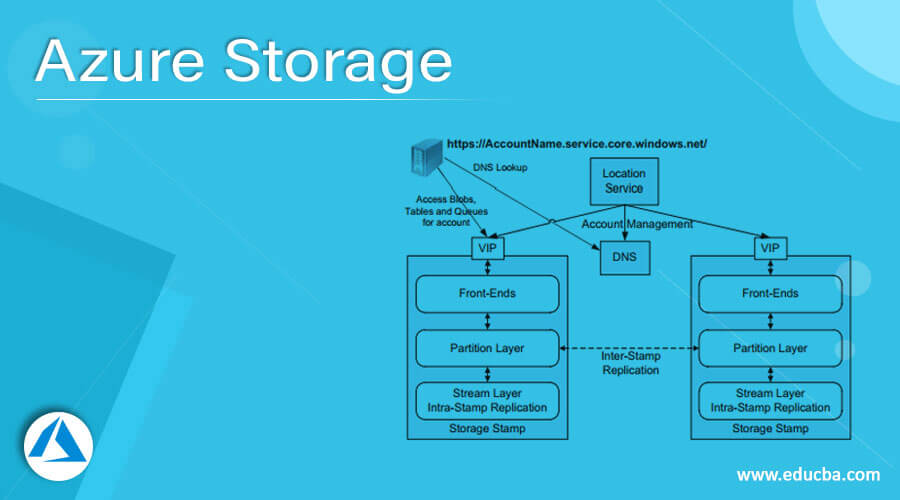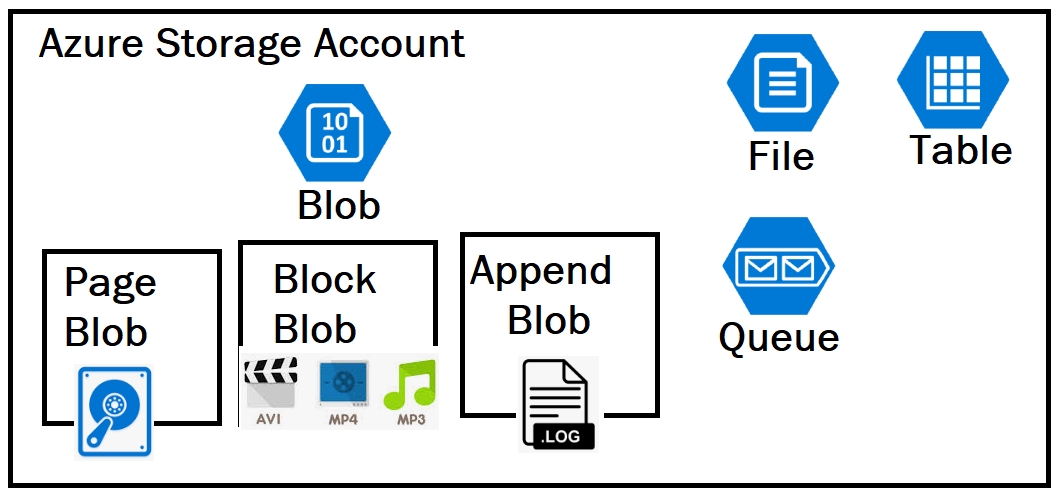An Overview of Microsoft Azure Storage Services
Microsoft Azure Storage services offer a comprehensive suite of cloud storage solutions designed to cater to a wide range of data storage and management needs. These services, which include Blob, File, Queue, and Disk storage, provide scalable, secure, and highly available options for storing and accessing unstructured, structured, and semi-structured data. The importance of Azure Storage services lies in their ability to support various data-intensive workloads, from web and mobile applications to big data analytics and machine learning.
Understanding the different storage options available in Azure Storage is crucial for organizations looking to optimize their cloud storage strategy. Blob Storage, for instance, is ideal for storing unstructured data, such as text and binary files, while File Storage provides a shared file system that can be accessed via the standard Server Message Block (SMB) protocol. Queue Storage, on the other hand, enables reliable messaging for asynchronous communication between application components, and Disk Storage offers managed and unmanaged disks for virtual machine workloads.
With the ever-growing demand for cloud storage, it is essential to consider the factors that influence Microsoft Azure Storage pricing. By familiarizing yourself with these factors, you can make informed decisions when designing and implementing your cloud storage infrastructure, ultimately leading to cost savings and improved performance.
Factors Influencing Microsoft Azure Storage Pricing
When evaluating Microsoft Azure Storage pricing, it is essential to consider several key factors that can significantly impact your overall costs. These factors include storage capacity, transaction costs, data redundancy, and data transfer.
Storage Capacity
The amount of data you store in Azure Storage directly influences your costs. Azure Storage offers various redundancy options, such as Locally Redundant Storage (LRS), Zone-Redundant Storage (ZRS), Geo-Redundant Storage (GRS), and Read-Access Geo-Redundant Storage (RA-GRS), which can affect the pricing based on the level of data protection and availability you require.
Transaction Costs
Transaction costs in Azure Storage are associated with operations such as reading, writing, and deleting data. These costs can vary depending on the storage service and the type of transaction. For instance, Blob Storage and File Storage have different transaction pricing models, and the cost can also depend on the number of operations performed within a specific time frame.
Data Redundancy
Data redundancy options in Azure Storage, as mentioned earlier, can impact your pricing. LRS, ZRS, GRS, and RA-GRS offer varying levels of data protection and availability, with corresponding price differences. Choosing the appropriate redundancy option is crucial for balancing data protection, availability, and cost.
Data Transfer
Data transfer costs in Azure Storage depend on the amount and direction of data movement. Incoming data transfers, also known as “inbound data,” are typically free, while outgoing data transfers, or “outbound data,” can incur costs. Data transfer costs can vary depending on the storage service, the location of the data, and the destination of the data transfer.
Understanding these factors is crucial for creating a cost-effective and optimized Azure Storage strategy. By carefully considering your storage requirements, transaction volume, data redundancy needs, and data transfer patterns, you can minimize your Azure Storage costs while ensuring high availability, performance, and data protection.
Breakdown of Microsoft Azure Storage Pricing: Blob Storage
Azure Blob Storage is a popular choice for storing unstructured data, such as text and binary files. Blob Storage offers three different tiers to accommodate various data access patterns and cost constraints: hot, cool, and archive. Each tier has a unique pricing structure based on storage capacity, data access, and data transfer fees.
Hot Tier
The hot tier is designed for data that is frequently accessed and requires rapid accessibility. This tier has higher storage costs compared to the cool and archive tiers but offers lower access costs. The hot tier is an ideal choice for storing data that is actively being used or modified, such as temporary data, frequently accessed media content, or hot backup data.
Cool Tier
The cool tier is intended for data that is infrequently accessed but still needs to be quickly retrieved when required. This tier has lower storage costs than the hot tier but higher access costs. The cool tier is suitable for storing data that will be accessed less frequently, such as long-term backup data, older media content, or data that is temporarily stored for analysis.
Archive Tier
The archive tier is designed for data that is rarely accessed and has a long retention period. This tier has the lowest storage costs but the highest access costs and longest retrieval times. The archive tier is ideal for storing data that can tolerate retrieval latencies, such as long-term archival data, compliance data, or data that is rarely accessed but must be retained for regulatory purposes.
Data Access and Data Transfer Fees
In addition to storage costs, Blob Storage also charges data access and data transfer fees. Data access fees are associated with reading, writing, and deleting data, while data transfer fees depend on the amount and direction of data movement. Incoming data transfers are typically free, while outgoing data transfers can incur costs. It is essential to consider these fees when designing your Blob Storage strategy to minimize costs and optimize performance.
By understanding the cost structure of Azure Blob Storage, you can make informed decisions about which tier to use for your data and optimize your storage costs accordingly. Carefully evaluating your data access patterns, storage requirements, and cost constraints will help you create a cost-effective and efficient Blob Storage strategy.
Breakdown of Microsoft Azure Storage Pricing: File Storage
Azure File Storage offers fully managed file shares that can be accessed via the standard Server Message Block (SMB) protocol. This service is ideal for organizations looking to lift and shift their on-premises file servers to the cloud or for applications that require a shared file system. The pricing for File Storage includes costs associated with capacity, transactions, and data transfers.
Capacity Costs
Capacity costs in File Storage are based on the amount of data stored in your file shares. Similar to Blob Storage, File Storage offers various redundancy options, such as Locally Redundant Storage (LRS), Zone-Redundant Storage (ZRS), Geo-Redundant Storage (GRS), and Read-Access Geo-Redundant Storage (RA-GRS), which can affect the pricing based on the level of data protection and availability you require.
Transaction Costs
Transaction costs in File Storage are associated with operations such as reading, writing, and deleting data. These costs can vary depending on the number of operations performed within a specific time frame. For instance, frequently accessed file shares or applications that perform many file operations may incur higher transaction costs.
Data Transfer Costs
Data transfer costs in File Storage depend on the amount and direction of data movement. Incoming data transfers, also known as “inbound data,” are typically free, while outgoing data transfers, or “outbound data,” can incur costs. Data transfer costs can vary depending on the location of the data and the destination of the data transfer.
Understanding the pricing model for Azure File Storage is essential for creating a cost-effective and optimized storage strategy. By carefully considering your storage requirements, transaction volume, and data transfer patterns, you can minimize your File Storage costs while ensuring high availability, performance, and data protection.
Breakdown of Microsoft Azure Storage Pricing: Queue Storage
Azure Queue Storage is a messaging service that decouples components of cloud applications, enabling asynchronous communication between application components. Queue Storage pricing includes costs associated with messages, storage capacity, and data transfers.
Message Costs
Message costs in Queue Storage are based on the number of messages and the size of each message stored in your queues. Queue Storage supports a maximum message size of 64 KB for metadata and up to 4 MB for message bodies. The more messages you store and the larger their size, the higher the message costs will be.
Storage Capacity Costs
Storage capacity costs in Queue Storage are based on the amount of data stored in your queues. Similar to Blob and File Storage, Queue Storage offers various redundancy options, such as Locally Redundant Storage (LRS), Zone-Redundant Storage (ZRS), Geo-Redundant Storage (GRS), and Read-Access Geo-Redundant Storage (RA-GRS), which can affect the pricing based on the level of data protection and availability you require.
Data Transfer Costs
Data transfer costs in Queue Storage depend on the amount and direction of data movement. Incoming data transfers, also known as “inbound data,” are typically free, while outgoing data transfers, or “outbound data,” can incur costs. Data transfer costs can vary depending on the location of the data and the destination of the data transfer.
Understanding the pricing model for Azure Queue Storage is essential for creating a cost-effective and optimized storage strategy. By carefully considering your message volume, storage requirements, and data transfer patterns, you can minimize your Queue Storage costs while ensuring high availability, performance, and data protection.
Breakdown of Microsoft Azure Storage Pricing: Disk Storage
Azure Disk Storage provides durable, high-performance block storage for Azure Virtual Machines (VMs). Disk Storage offers two types of managed disks: Managed Disks and Unmanaged Disks. Managed Disks simplify disk management by handling storage account creation, while Unmanaged Disks require manual storage account management. The pricing for Disk Storage includes costs associated with capacity, transactions, and snapshots.
Capacity Costs
Capacity costs in Disk Storage are based on the amount of data stored in your managed and unmanaged disks. Azure offers various disk types, such as Ultra Disks, Premium SSDs, Standard SSDs, and Standard HDDs, with varying performance levels and costs. The more data you store and the higher the performance level, the higher the capacity costs will be.
Transaction Costs
Transaction costs in Disk Storage are associated with read and write operations performed on your managed and unmanaged disks. These costs can vary depending on the number of operations performed within a specific time frame and the disk type. For instance, Ultra Disks and Premium SSDs, which offer higher performance levels, may incur higher transaction costs.
Snapshot Costs
Snapshot costs in Disk Storage are based on the amount of data stored in your disk snapshots. Snapshots are point-in-time copies of your managed or unmanaged disks and are useful for backup and disaster recovery purposes. Similar to capacity costs, the more data you store in your snapshots, the higher the snapshot costs will be.
Understanding the pricing model for Azure Disk Storage is essential for creating a cost-effective and optimized storage strategy. By carefully considering your storage requirements, performance needs, and transaction volume, you can minimize your Disk Storage costs while ensuring high availability, performance, and data protection.
How to Optimize Microsoft Azure Storage Costs
Organizations using Microsoft Azure Storage services can employ various strategies to optimize their storage costs. These strategies include using lifecycle management policies, monitoring usage, and leveraging reserved capacity. By implementing these tips, you can minimize your Azure Storage costs while ensuring high availability, performance, and data protection.
Utilize Lifecycle Management Policies
Azure Blob Storage and Azure Files support lifecycle management policies that enable automatic data tiering and deletion based on specified rules. By moving infrequently accessed data to lower-cost storage tiers, such as the cool or archive tier in Blob Storage, you can reduce storage costs without sacrificing data availability. Additionally, you can set rules to delete older, unnecessary data, further optimizing your storage costs.
Monitor Usage and Adjust Resources Accordingly
Regularly monitoring your Azure Storage usage can help you identify trends, patterns, and potential cost-saving opportunities. Azure provides built-in monitoring tools, such as Azure Monitor and Azure Metrics, that enable you to track storage usage, performance, and costs. By analyzing this data, you can adjust your storage resources, such as downsizing or upsizing storage accounts, to better match your needs and optimize costs.
Leverage Reserved Capacity
Azure offers reserved capacity options for Disk Storage, enabling you to reserve a specific amount of disk space for a fixed term at a discounted rate. By committing to a reserved capacity plan, you can save up to 65% compared to pay-as-you-go pricing. This option is ideal for organizations with predictable and stable storage requirements, as it provides cost savings and improved budgeting capabilities.
By implementing these strategies, you can optimize your Microsoft Azure Storage costs and ensure that your storage infrastructure is both cost-effective and high-performing. Regularly reviewing and updating your storage strategy can help you maintain optimal costs and take advantage of new features and cost-saving opportunities as they become available.
Comparing Microsoft Azure Storage Pricing with Competitors
When evaluating cloud storage providers, understanding the pricing structure and comparing costs with competitors is crucial. Microsoft Azure Storage pricing competes with other leading cloud storage providers, such as Amazon S3 and Google Cloud Storage. By comparing the pricing models and unique value propositions of these providers, organizations can make informed decisions about which platform best suits their needs.
Microsoft Azure Storage Pricing vs. Amazon S3
Amazon S3 offers a similar storage pricing model to Azure Storage, with costs associated with storage capacity, transactions, and data transfer. However, Azure Storage provides more granular storage tiering options, such as the hot, cool, and archive tiers in Blob Storage, allowing for more precise cost optimization. Additionally, Azure Storage offers more flexible and cost-effective Disk Storage options, including managed and unmanaged disks, and snapshot costs.
Microsoft Azure Storage Pricing vs. Google Cloud Storage
Google Cloud Storage also competes with Azure Storage in terms of pricing and features. Google Cloud Storage offers various storage classes, such as Standard, Nearline, Coldline, and Archive, which are similar to Azure Storage’s hot, cool, and archive tiers. However, Azure Storage’s managed disks and snapshot costs provide more flexibility and cost savings compared to Google Cloud Storage’s persistent disks.
The Unique Value Proposition of Azure Storage
Azure Storage offers several unique features that differentiate it from competitors, including:
- Seamless integration with Azure services, such as Azure Virtual Machines, Azure Functions, and Azure Data Factory, enabling a cohesive and efficient cloud infrastructure.
- Advanced security features, such as Azure Storage Service Encryption, Azure Active Directory integration, and role-based access control, ensuring secure data storage and access.
- Azure Archive Storage, which offers the lowest-cost storage option for long-term retention and disaster recovery scenarios, with retrieval times of hours.
- Azure Files, which provides fully managed file shares in the cloud, enabling a seamless lift-and-shift of on-premises file servers to the cloud.
By comparing Microsoft Azure Storage pricing with competitors and understanding its unique value proposition, organizations can make informed decisions about which cloud storage provider best suits their needs. Azure Storage’s granular storage tiering options, flexible Disk Storage, and advanced security features make it a strong contender in the cloud storage market.







